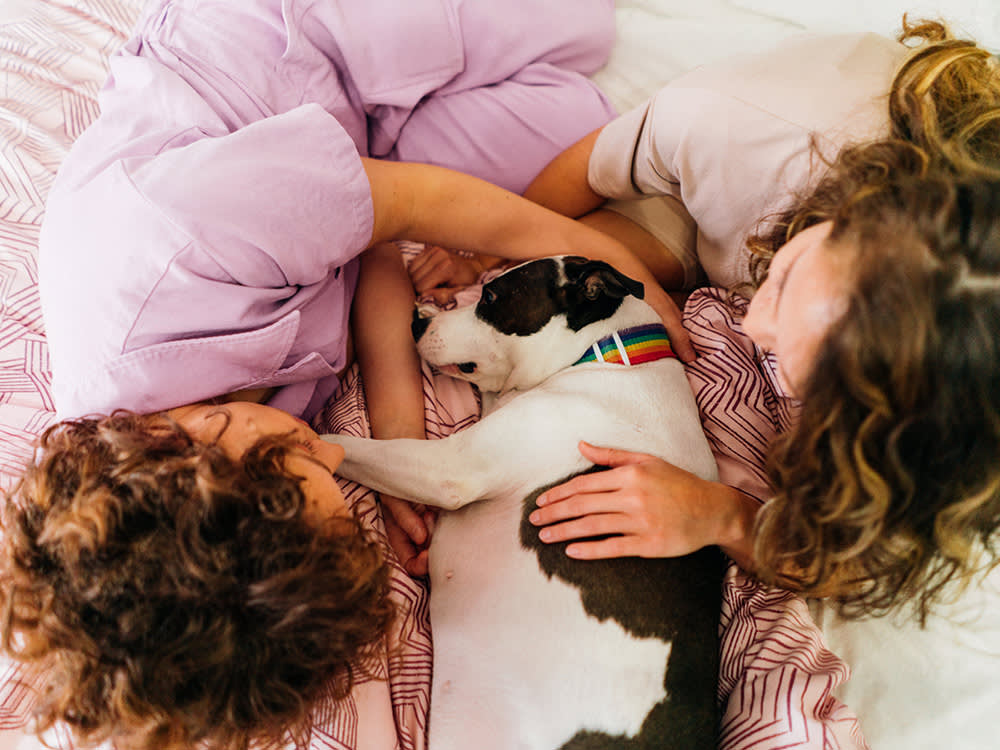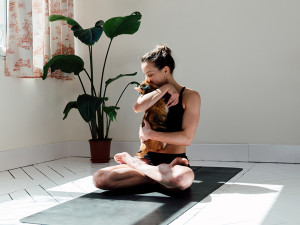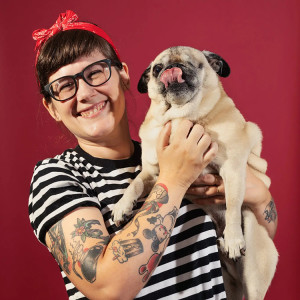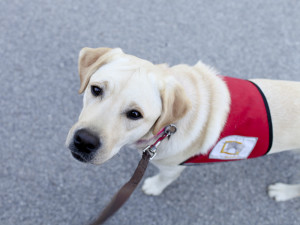Does Your Dog Have Therapy Dog Potential?
Renowned animal behaviorist Patricia McConnell, PhD, on what it takes to be a great therapy dog.
I wish I could say I’m making this up but I once had a client tell me, “My dog would be perfect as a therapy dog — perfect. You just have to help me stop him from biting so much.” He had the best of intentions, but his pathologically shy and potentially dangerous dog was no better suited to therapy work than I am to being a ballerina.
Numerous studies have shown the physical and emotional health benefits of dogs. Therapy dog work brings those amazing benefits to vulnerable folks in hospitals and senior centers, and it makes my heart all warm and gooey to think of the great work they do. Currently, an estimated 30,000 teams of therapy dogs and handlers are certified through Pet Partnersopens in new tab and Therapy Dogs Internationalopens in new tab, and there is little doubt that they are enriching the lives of thousands of people across the country.
Trick question: All dogs are perfect! But find out which type is the best fit for you.
What do therapy dogs do?
A good dog-and-handler team does a lot more than just make people feel fleetingly happy. True therapy dogs — dogs who participate in structured programs designed by health care professionals (Animal-Assisted Therapy, or AAT) — can decrease pain, improve mobility, speed up post-surgery healing and even calm autistic children as well as increase their social interactions. That’s a pretty impressive body of work, and it is just the shortlist.
A larger number of dogs and handlers participate in work called Animal-Assisted Activities (AAA), in which teams visit hospitalized children and senior-center residents. The petting, tricks and furry companionship can stimulate the release of massive quantities of the world’s greatest drug, the neurohormone oxytocin.
How much do you spend on your pet per year?
This work can be as good for the handlers as the recipients. Watching a senior citizen glow while petting your dog is guaranteed to put you in a good mood that lasts for hours. But, you need to leave your rose-colored glasses at home if you and your dog are involved in therapy work (I’m just going to loosely call it “therapy” from now on). Just because you love your dog doesn’t mean everyone in a nursing home will want to meet them. Plus, your dog may actually hate the work, even though it wraps you in a haze of oxytocin. Or, your pup may come home with antibiotic-resistant bacteria like MRSAopens in new tab, which is commonly found in healthcare facilities.
In other words, there’s a lot to learn about doing this work in a way that is truly helpful to others, safe for everyone involved, and, as importantly, enjoyable for your dog. Although therapy animals come in all shapes and sizes, I’ll be focusing on dogs in this article because they pretty much drive the system.
What makes a good therapy dog?
Let’s start with a question: Which dogs are appropriate for therapy dog work? Answer: Not many. Ouch. Sorry, but the fact is that therapy work can be tiring and stressful for many dogs, and some dogs have personalities that take them out of the running even though they would love to be on the team.
An overexuberant dog might make a good therapy dog when they’re a senior, but as an adolescent, they might simply be too much “dog” to visit vulnerable populations. Imagine a dog with good manners that keeps all four feet on the ground, but in their enthusiasm to meet new people, they quiver and lick and thrash their tail around like some crazed dishrag on drugs. It’s a good reminder that no matter how much you love your dog, they may not be a candidate for therapy work, at least not now.
Here are some criteria to consider when asking if your dog is suitable for therapy work:
Therapy dogs must love people and human contact.
Therapy dogs must be emotionally calm and at ease in all situations.
Therapy dogs must be physically calm with good manners and an appropriate personality.
Your dog should be a people-loving pup.
The most important job qualification is that your dog loves people, absolutely and completely. That doesn’t mean your pup lights up when you come home and tolerates visitors. I’ve seen and heard of numerous dogs in training for therapy dog work who adored their person — but strangers? Not so much. I’ve also watched a dog and handler spend an entire “therapy” session bonding with one another in a nursing home. That’s not therapy; that’s a pet parent petting their dog while others watch. It might be useful in some circumstances, but most often, the dog needs to voluntarily approach strangers, make eye contact with them, and put forth an effort to get close to them.
It’s important to distinguish these dogs from dogs who merely tolerate strangers. My dog’s response to people walking toward the house is: “Oh, look! There’s another one! Can you believe it?” I get the impression he thinks that people are as rare as huge, juicy beef bones, and he just can’t believe his luck — they keep turning up randomly when he least expects them. So while he’d fill the “loves everyone” bill, he’d, uh, most likely knock an elderly person out of their wheelchair with his tail.
Your dog must have more than good manners.
This brings us to the difference between manners and personality. Your dog might greet people politely with good manners, but you can’t expect them to leave their personality in the crate. Therapy dogs need to be calm — dogs who don’t slap senior citizens with their tails or pull IVs out of patients’ arms. The level of acceptable activity can vary depending on where and when the dog is working, but a calm demeanor goes beyond good training.
People who most benefit from a dose of oxytocin are often frail or otherwise physically compromised, and the dogs they interact with can’t emote all over them, forcing them to protect their face or their shoulder or their new hip. This is one reason so many dogs do well when they are older, even though they may have flunked the certification test when they were younger. If your dog was dismissed as too active to work in the Children’s Hospital when he was three, you might want to try again when he’s eight or ten, after he’s slowed down and is a little calmer about life in general.
Your dog must be a zen master.
Besides being physically calm, dogs need to be emotionally calm. That means they don’t go all pancake-eyed when someone grabs their head or panic if a metal tray is dropped behind them. Essentially, a good therapy dog needs to behave in ways that most dogs don’t: unfazed when a child hugs them a little too hard before you can intervene, unreactive when the Alzheimer’s patient tries to grab their ears, and screams when you step in.
Can some nervous dogs be conditioned to be comfortable when “life happens”? Yes, they can; I know of several dogs who were originally terrified of strangers and ended up as great therapy dogs. But that’s the exception, not the rule. It’s a fool’s errand to try to make a reactive dog into a good therapy dog while they’re in treatment themselves, and it’s not safe or respectful to anyone to try to make a “regular” dog into a one-in-a-million one.
This is a problem I’ve seen a bit too often: pet parents whose dogs may have good reasons for being cautious or nippy but who still insist that “it’s not the dog’s fault, and if everyone would just learn to be appropriate around dogs, they’d be perfect.” That’s pretty much the point here: people won’t be perfect, guaranteed. In the normal run of things, they never are, and in the case of therapy, they often will be worse. The children will be crazed to finally see a dog like the one they have at home—they won’t understand why they can’t hug your dog so hard that your pup can’t breathe. Some seniors will sit quietly stroking your dog, but others will get a death grip on the sides of the dog’s head and kiss their lips before you can stop them.
For everyone’s sake, including your own, you don’t want a therapy dog that just barely tolerates this kind of treatment. Those dogs may be “fine” (i.e., they don’t bite) the first time or two, but they might not be the third or fourth. Even if they don’t object, forcing them to tolerate this sort of behavior could be considered abusive. You need a dog who really, truly doesn’t care if they’re hugged, or their tail is pulled. Those dogs are out there, but they are less common than many of us like to think.
Responsibilities of Therapy Dog Handlers
And that brings us to another critical issue: your responsibility as your dog’s handler. Here are a few responsibilities as a handler for therapy dog work.
Be your dog’s advocate.
Be able to read your dog’s body language.
Be objective.
You must support your dog.
Although I’ve already noted that a therapy dog must be able to tolerate all manner of rudeness, it’s your job to eliminate as much stress as you possibly can. You may not be able to do this 100 percent of the time (thus my cautions about your dog’s training and personality), but as the human half of the team, you play several roles, and one of them is to be your dog’s advocate. This includes knowing your dog well enough to predict which environment they would do well.
Some dogs, for example, would be overstimulated in a room full of children but might be great for a senior facility. Some dogs adore kids but would be nervous around wheelchairs and walkers. Thus, your first job is to find out which program is a good fit for your dog. If you’re involved with a group like Pet Partners or Therapy Dogs International, the organization will help you identify an appropriate venue after your dog has been certified.
You must be an expert at reading your dog.
Once you’re on location, your task is to present your dog to others and then back off enough to encourage connections. However, you need to stay alert and watch for potentially inappropriate interactions. Most importantly, you need to be an expert at reading your dog. If I’ve heard “Oh, they’re fine,” about a stiff-bodied, closed-mouthed, wrinkled-brow dog once, I’ve heard it a gazillion times.
A woman sent me a video of her and her dog doing therapy work in a hospital setting. The children were in heaven, petting and stroking and chattering like starlings over the dog. The woman was beaming and raved to me about how much her dog loved the work. Except that’s not what her dog’s body language suggested. He looked patently miserable, with a stiff body, his mouth closed and his head turned away from the children. His human was so overwhelmed with oxytocin herself that she couldn’t see that her dog was extremely uncomfortable.
You must escape the oxytocin and be objective.
Therapy dog handlers need to become brilliant at interpreting visual signals of discomfort in their dog and learning to act on them immediately. That’s not always so easy to do; many of us have seen a suspicious look on our dog’s face and dismissed it. “Oh, but they’ve always loved coming here.” But maybe that was then, and this is now. Therapy work can be the highlight of a dog’s week, but it can also be stressful, and it’s common for dogs to enjoy it for a few years and then be ready for retirement.
What’s most important is learning to read your dog objectively and to do so every minute of every interaction. If you’re participating in therapy dog work with your dog, you are the responsible member of a team, and you need to watch and evaluate the patient, the surroundings, and your dog. If you don’t come home a little tired, you’re probably not doing your job.
Argh! This sounds like a lot. It is if you do it right, that’s true. However, many people say it’s the most rewarding thing they’ve ever done with their dog. I don’t want these cautions to discourage anyone from doing therapy work with their dog. This can be important and wonderful work — good for you, good for your dog, and good for people desperate for the same glow you get when you cuddle with your dog at night. Spreading joy is a beautiful thing — but it needs to be done with knowledge and foresight so that it’s a win for everyone.
Therapy Dog Resources
Therapy Dogs Today: Their Gifts, Our Obligation (Funpuddle Publishing, 2013).
The Handbook on Animal-Assisted Therapy: Theoretical Foundations and Guidelines for Clinical Practice (Elsevier Science, 2010).
Animals in Our Lives; Human-Animal Interaction in Family, Community & Therapeutic Settings (Paul H. Brooke, 2011).
Lending a Helping Paw: A Video Guide to Animal Assisted Therapy (Dogwise, 2012)






